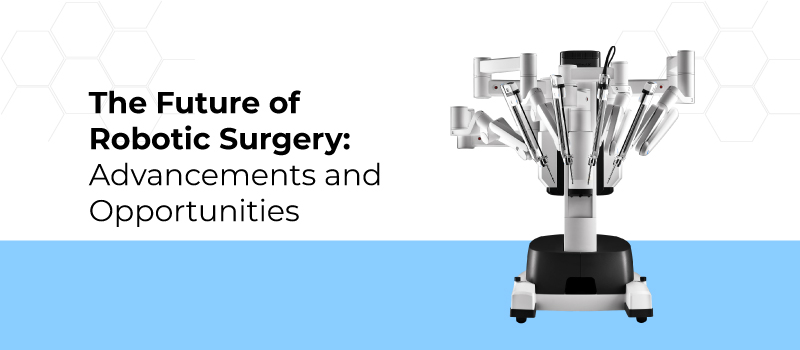Future of Robotic Surgery_ Advancements and Opportunities
Asian Institute of Nephrology and Urology | May 15, 2024

Table Of Contents
The Future of Robotic Surgery: Advancements and Opportunities
In recent times, the technological advancement in the medical world has been rapid and revolutionary. Robotic surgery is one of the most unique and extraordinary innovations in health and wellness. As the name suggests, robotic surgery is a surgical procedure wherein mechanical arms are controlled by a surgeon for surgical maneuvering. In this post, we will check the A to Z of robotic surgery, including its future, advancements, and other nitty-gritties.
What is robotic surgery?
Robotic or robot-assisted surgery, is a medical procedure that enables doctors to perform various complex surgeries with precision, flexibility, and control. The first robotic surgery was performed in 1985 by the PUMA 560 for neurosurgical biopsies. Thereafter, the mechanism has evolved and is utilized in an array of surgical specialties, especially in urology.
It is essential to note that robotic surgery is mostly linked to minimally invasive surgeries, which are performed through tiny incisions. It often serves as an alternative method for specific open surgeries. The most typical and widely prevalent clinical robotic surgical system encompasses a camera arm and mechanical arms with surgical instruments attached to them.
The surgeon controls the arms while seated at a computer device (console) near the operation table. The console offers the surgeon a high-definition, magnified, and 3D view of the surgical site. The head surgeon leads other team members at the patient side who also assist during the operation.
When and why is robotic surgery performed?
Despite having a fairly short history, robot-assisted surgeries have gained immense popularity worldwide. The technique is preferred because it enhances precision, flexibility, and control during an operation and enables the surgeon to better see the site as compared to conventional methods. Robotic surgery allows surgeons to perform delicate and complicated procedures that may be incredibly challenging or impossible with other strategies.
Many conditions have been successfully addressed and treated with robotic-assisted surgeries in Uro-oncology.
- Partial Nephrectomy - Surgical removal of the tumor of kidney while preserving the healthy part
- Robotic Prostatectomy - Surgical removal of cancerous prostate.
- Robotic radical cystectomy - Surgical removal of cancerous bladder.
These include:
Now that we know about the basics, let us gauge the future of robotic surgery and the interim advancements.
Advancements in Robotic Surgery: A Beginner’s Guide
In recent years, the realm of robotic surgery has witnessed phenomenal advancements, such as:
- The Da Vinci System
Intuitive Surgical's Da Vinci Surgical System is a popular and helpful invention. It has been used in more than 5 million surgeries worldwide and continues to evolve rapidly. The updated versions of the system, the Da Vinci X & Xi, were designed and devised to be more versatile and easy-to-use than its erstwhile counterpart.
The Future of Robotic Surgery
The future of robotic surgery is quite bright. We can expect further advancements in the field. Some experts even suggest that robot-assisted surgeries and procedures will become the norm in the near future. Likewise, with more interest in the domain, robotic surgical systems are bound to become more accessible and affordable.
Some tangible predictions for the upcoming years are:
-
Increased availability and affordability
As robotic surgery becomes more ubiquitous, robotic surgical machines will become more accessible and budget-friendly. Such as decrease in costs will ensure that everyone receives the right kind of treatment and that global parity is achieved in health and technology.
-
Microsurgeries and Miniaturization of Robots
The robots performing surgeries are bound to become smaller and more precise. Their ability to perform surgeries on delicate parts of the human body with greater accuracy and minimal invasiveness will increase. For instance, human testing of a robot performing a ‘super microsurgery’ or surgery of 0.3 to 0.8 mm vessels is currently underway. If the trial is a success, robots will be able to repair and mend microvasculature with higher precision and speed.
-
AI Integration
Quite understandably, artificial intelligence’s mushrooming and integration will continue in robotic surgical mechanisms. In due course, the autonomy and accuracy of these methods will also increase.
-
Haptic Feedback
Advancements in haptic technology will enable surgeons to feel and manipulate tissues in real-time. Thus, the precision and humaneness of robotic-assisted surgery will be further bolstered.
- Fewer complications, such as surgical site infections
- Less blood loss
- Less pain and discomfort
- The surgeon has a greater range of motion and dexterity.
- The surgeon is equipped with a highly magnified, 3D, and high-resolution view of the operating site.
- smaller and less noticeable scars
- Shorter hospital stays
- Quicker recovery
- Fewer blood transfusions
- Fewer complications during surgery
- The surgeon has better access to the deeper area being operated on.
The Top Benefits of Robotic Surgery
Let us wrap up the post by checking out some of the benefits of robotic surgery. These include:
Wrapping It Up
So, there we have it: a quick overview of what robotic surgery is, its advancements, and what we can expect in the future. Robotic surgery comes with several benefits and minimal risks. However, if you are interested in the procedure, it is crucial to know when to consult a doctor. He or she will advise you on the optimal technique.







